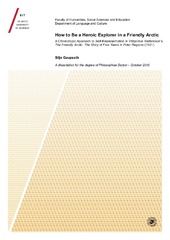| dc.contributor.advisor | Schimanski, Johan | |
| dc.contributor.author | Gaupseth, Silje | |
| dc.date.accessioned | 2017-01-24T13:18:59Z | |
| dc.date.available | 2017-01-24T13:18:59Z | |
| dc.date.issued | 2017-02-03 | |
| dc.description.abstract | This dissertation deals with the exploration account The Friendly Arctic: The Story of Five Years in Polar Regions (1921), written by Canadian-American anthropologist and explorer Vilhjalmur Stefansson (1879–1962). Stefansson’s story is based on his experiences during the Canadian Arctic Expedition, which traversed and mapped stretches of ocean and land in the Canadian Arctic in the years 1913–1918. The methodological and theoretical approach of the study is largely based on Mikhail Bakthin’s concept of the chronotope, which is combined with relevant concepts and analytical approaches from narrative theory and method. In order to understand Stefansson’s narrative self-representation in The Friendly Arctic, the study contends, two interdependent—and potentially conflicting—chronotopes that give form to his narrative must be examined: a friendly Arctic chronotope and a quest chronotope, which combine elements of plot and character, story and discourse. Against this background, the self-representation of Stefansson as Arctic explorer (basing his characteristic explorative techniques on Inuit knowledge) may sometimes be seen as ambivalent, and there is a similar tension in the narrative representation of his friendly Arctic. The study is of relevance to the field of travel and exploration literature, and is influenced by recent work on Arctic discourses. | en_US |
| dc.description.doctoraltype | ph.d. | en_US |
| dc.description.popularabstract | Avhandlingen tar for seg The Friendly Arctic: The Story of Five Years in Polar Regions (1921), ekspedisjonsberetninga til den canadisk-amerikanske antropologen og utforskeren Vilhjalmur Stefansson, som ledet The Canadian Arctic Expedition til Canadas nordligste strøk i årene 1913–1918. Ved å lese Stefanssons beretning som litteratur i stedet for som faktaberetning, dvs. i lys av narrativ teori og metode, og særlig Mikhail Bakhtins kronotopbegrep, tegner det seg et heller tvetydig bilde av den tradisjonelle polarhelten som kjemper mot et fiendtlig landskap. Stefanssons selvfremstilling må nemlig ses i sammenheng med det bildet han tegner av et vennlig og fruktbart, nærmest idyllisk Arktis. Men spørsmålet som uunngåelig melder seg—og som Stefansson må forsøke å besvare gjennom hans egen beretning—blir da: Hvordan kan man fremstå som polarhelt i et vennlig Arktis? | en_US |
| dc.description.sponsorship | UiT The University of Tromsø
Norges forskningsråd | en_US |
| dc.identifier.uri | https://hdl.handle.net/10037/10216 | |
| dc.language.iso | eng | en_US |
| dc.publisher | UiT Norges arktiske universitet | en_US |
| dc.publisher | UiT The Arctic University of Norway | en_US |
| dc.rights.accessRights | openAccess | en_US |
| dc.rights.holder | Copyright 2017 The Author(s) | |
| dc.rights.uri | https://creativecommons.org/licenses/by-nc-sa/3.0 | en_US |
| dc.rights | Attribution-NonCommercial-ShareAlike 3.0 Unported (CC BY-NC-SA 3.0) | en_US |
| dc.subject | Exploration literature | en_US |
| dc.subject | Vilhjalmur Stefansson | en_US |
| dc.subject | Chronotope | en_US |
| dc.subject | The Friendly Arctic | en_US |
| dc.subject | VDP::Humaniora: 000::Litteraturvitenskapelige fag: 040::Allmenn litteraturvitenskap: 041 | en_US |
| dc.subject | VDP::Humanities: 000::Literary disciplines: 040::General literary science: 041 | en_US |
| dc.subject | VDP::Samfunnsvitenskap: 200::Samfunnsgeografi: 290 | en_US |
| dc.subject | VDP::Social science: 200::Human geography: 290 | en_US |
| dc.title | How to Be a Heroic Explorer in a Friendly Arctic: A Chronotopic Approach to Self-Representation in Vilhjalmur Stefansson’s The Friendly Arctic: The Story of Five Years in Polar Regions (1921) | en_US |
| dc.type | Doctoral thesis | en_US |
| dc.type | Doktorgradsavhandling | en_US |


 English
English norsk
norsk
